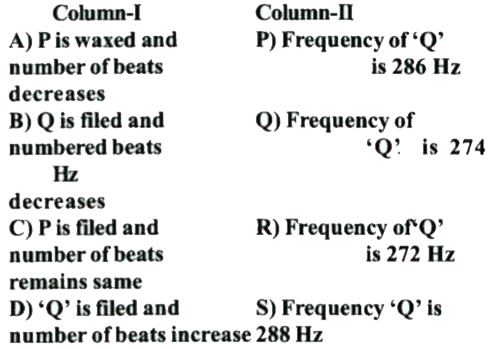A tuning fork of unknown frequency gives 4beats with a tuning fork of frequency 310 Hz. It gives the same number of beats on filing. Find the unknown frequency.
To find the unknown frequency of the tuning fork, we can follow these steps:
Step 1: Understand the concept of beats
Beats occur when two sound waves of slightly different frequencies interfere with each other. The number of beats per second is equal to the absolute difference between the two frequencies.
Step 2: Set up the known values
We know that the frequency of the known tuning fork (N2) is 310 Hz and that it produces 4 beats with the unknown frequency (N1).
Step 3: Use the beat frequency formula
The beat frequency (number of beats per second) is given by:
Beats=|N1−N2|
In this case, we have:
4=|N1−310|
Step 4: Solve for N1
This equation gives us two possible scenarios:
1. N1−310=4
2. 310−N1=4
From the first scenario:
N1=310+4=314Hz
From the second scenario:
N1=310−4=306Hz
Step 5: Consider the effect of filing
When the tuning fork is filed, its frequency increases. If the unknown frequency was 306 Hz, filing would increase it, potentially leading to a situation where the number of beats would change. However, since it is stated that the number of beats remains the same after filing, this implies that the unknown frequency must be the higher value.
Step 6: Conclusion
Thus, the unknown frequency (N1) must be:
N1=306Hz
Final Answer
The unknown frequency of the tuning fork is 306 Hz.
---
Beats occur when two sound waves of slightly different frequencies interfere with each other. The number of beats per second is equal to the absolute difference between the two frequencies.
We know that the frequency of the known tuning fork (N2) is 310 Hz and that it produces 4 beats with the unknown frequency (N1).
The beat frequency (number of beats per second) is given by:
Beats=|N1−N2|
In this case, we have:
4=|N1−310|
This equation gives us two possible scenarios:
1. N1−310=4
2. 310−N1=4
N1=310+4=314Hz
N1=310−4=306Hz
When the tuning fork is filed, its frequency increases. If the unknown frequency was 306 Hz, filing would increase it, potentially leading to a situation where the number of beats would change. However, since it is stated that the number of beats remains the same after filing, this implies that the unknown frequency must be the higher value.
Thus, the unknown frequency (N1) must be:
N1=306Hz
The unknown frequency of the tuning fork is 306 Hz.
Topper's Solved these Questions
- OSCILLATIONS AND WAVESBOOK - PRADEEPCHAPTER - OSCILLATIONS AND WAVESEXERCISE - CURIOSITY QUESTION
2 Videos
- OSCILLATIONS AND WAVESBOOK - PRADEEPCHAPTER - OSCILLATIONS AND WAVESEXERCISE - SOLVED EXAMPLES
54 Videos
- MATHEMATICAL TOOLSBOOK - PRADEEPCHAPTER - MATHEMATICAL TOOLSEXERCISE - Fill in the blanks
5 Videos
- PHYSICAL WORLD AND MEASUREMENTBOOK - PRADEEPCHAPTER - PHYSICAL WORLD AND MEASUREMENTEXERCISE - Competiton Focus Jee Medical Entrance
18 Videos
Similar Questions
A tuning fork A of frequency f gives 5 beats/s with a tuning fork B of frequency 512 Hz. If on filing A, the number of beats remains same, then find the value of f.
View SolutionA tuning fork of unknown frequency when sounded with another tuning fork of frequency 256 Hz produces 4 beats per second, and on loading with a little amount of wax, it again produces 4 beats per second. The unknown frequency is____________.
View Solution
Knowledge Check
A tuning fork of unknown frequency produces 4 beats per second when sounded with another tuning fork of frequency 254 Hz. It gives the same number of beats per second when unknown tuning fork loaded with wax . The unknown frequency before loading with wax is
A258B254C250DCan't be determinedA tuning fork of unknown frequency x, produces 5 beats per second with a tuning fork of frequency of 250 Hz. The produces 10 beats/second with another tuning fork frequency 265 Hz. The unknow frequency is
A245 HzB255 HzC275 HzD270 HzA tuning fork produces 2 beats per second when sounded with another tuning fork of frequency 250 Hz. It gives the same number of beats per second when loaded with wax. The initial frequency of 1st tuning fork is
A252 HzB248 HzC254 HzD246 Hz
A tuning fork A of unknown frequency produces 5 beats/s with a fork of known frequency 340 Hz. When fork A is filed, the beat frequency decreases to 2 beats/s. What is the frequency of fork A ?
View SolutionA tuning fork 'P' of frequency 280Hz produces 6 beats/s with unknown tuning fork 'Q'

View SolutionA tuning fork sounded together with a tuning fork of frequency 256 emits two beats. On loading the tuning fork of frequency 256, the number of beats heard are 1 per second. The frequency of tuning fork is
View SolutionWhen a tuning fork A of unknown frequency is sounded with another tuning fork B of frequency 256Hz, then 3 beats per second are observed. After that A is loaded with wax and sounded, the again 3 beats per second are observed. The frequency of the tuning fork A is
View SolutionA tuning fork A produces 4 beats/sec with another tuning fork B of frequency 320 Hz . On filing the fork A , 4 beats/sec are again heard. The frequency of fork A , after filing is
View Solution
